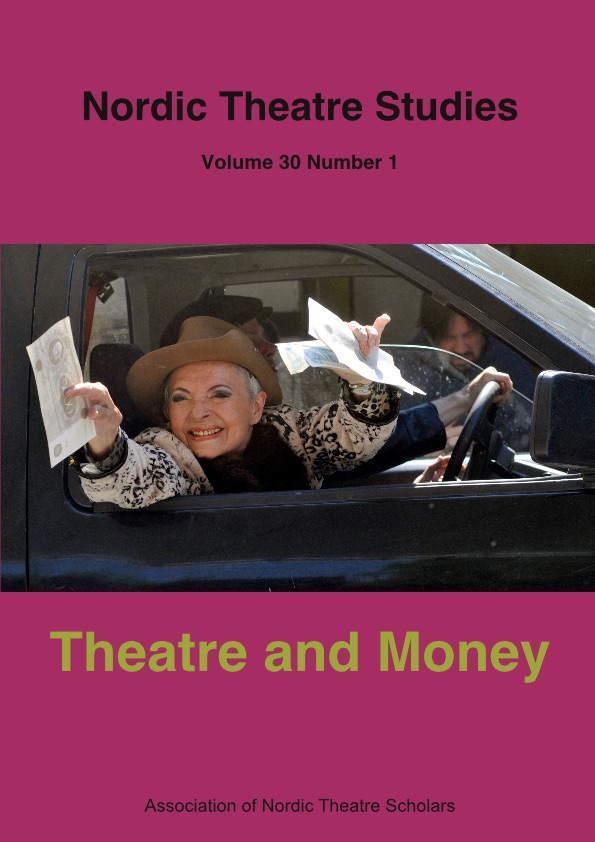Path Dependency in Theatre Funding
Venues and their Impact on Dance Productions in Estonia
DOI:
https://doi.org/10.7146/nts.v30i1.106923Keywords:
Contemporary dance, path dependency, theatre and dance fundingAbstract
Estonian contemporary dance emerged in the early 1990s outside established theatre institutions. Since then, it has existed in a project-based format, which means that though dance artists can receive funding for preparing projects, there is no financial support for facilities needed for everyday practice outside or between the projects. The type of venues available for practicing contemporary dance has an impact on choreographic practice presented for the public, even if that dimension often remains invisible.
Funding policy, like other policies, is greatly affected by the historical legacy of a particular policy (that is, path dependent), and the same can be claimed about choreographic practice. Therefore, in order to understand why a certain policy or practice prevails and is resistant to change even if it becomes problematic, it is necessary to look at the beginning of the path. In the present article, the history of theatre and dance funding in Estonia is taken as an example to discuss how that history affects the present in terms of choices by dance practitioners. Though Estonia is taken as an example, the situation is far from unique and therefore can serve as a case for analyzing similar situations in other countries.
References
Eesti Kultuurkapitali seadus. 1994. Riigi Teataja I/1994, 46, 772. https://www.riigiteataja.ee/akt/263188 (20 Oct 2017)
Einasto, Heili. 2014. “Transformations of the dancing body in Estonian contemporary dance” in Joanna Szymajda (ed.) European Dance since 1989. Communitas and the Other. London: Routledge, 75−90.
Karjahärm, Toomas and Väino Sirk. 2001. Vaim ja võim. Eesti Haritlaskond 1917-1940. Tallinn: Argo.
Kranig, Saima. 2017. Phone interview with Heili Einasto. Recording from 23 June 2017.
Kuhn, Thomas. 2003. Teadusrevolutsioonide struktuur. (The Structure of Scientific Revolutions, 1962). Tartu: Ilmamaa.
Kulka 2017. “Cultural Endowment News. Performing Arts Fund Looks for Residency Applications.” https://www.kulka.ee/uudised/naitekunsti-sihtkapital-ootab-residentuuritaotlusi (17 May 2017)
Kultuuriministeerium murrab pead teatrite rahastamise üle. 2002. BNS 16.01.
https://www.saarlane.ee/uudised/prindi.asp?newsid=7778&kat=2 (10 Nov 2017)
Lindepuu, Heili. 2012. Fine 5 Tantsuteatri lugu. Teater. Muusika. Kino, 11/2012, 72–81.
Lotman, Juri. 2013. The unpredictable workings of culture. Translated by Brian James Baer. Tallinn: TLU Press.
Ollesk, Tiina. 2017. Phone interview with Heili Einasto. Recording from 23 June 2017.
Pappel, Kristel. 2003. Ooper Tallinnas 19. sajandil. Tallinn: Eesti Muusikaakadeemia.
Peep, Lennart. 2017. “Kuidas idandada eesti teatrit.” Sirp 10.02.
Pfau-Effinger, Birgitte. 2005. “Culture and Welfare State Politics: Reflections on a Complex Interrelation.” Journal of Social Policy 34:1, 3–20.
Pierson, Paul. 2000. “Increasing Returns, Path Dependence, and the Study of Politics.” American Political Science Review 94:2, 251–267.
Riigikontroll auditeeris riigi teatripoliitikat. 2001. Riigikontroll, https://goo.gl/rGusjF
(5 Nov 2017)
Ruus, Katrin. 2006. “Kuidas sündis Von Krahl, puhta kunsti teater.” Postimees 23 Aug 2006.
Rander, Aare. 2008. Interview with Evelin Lagle on 23 March 2008.
Raudsepp, Evelyn. 2015. “Vastab Priit Raud.” Teater. Muusika. Kino, 7/2015,
http://www.temuki.ee/archives/1179 (10 Apr 2017)
Saarva, Merle. 2000. Interview with Heili Einasto on 5 April 2000.
Sibrits, Heili. 2012. “Tearite eelarve jaguneb kolmeks.” Postimees 19 June 2012.
STL 2017. “History of STL”, http://stl.ee/meist/ (10 Apr 2017)
Toepfer, Karl and Heili Einasto. 2017. “Tants mitte üksnes siin ja praegu: digitaalse revolutsiooni mõju.” Postimees 11 Nov 2017.
Tormis, Lea. 1967. Eesti balletist. Tallinn: Eesti Raamat.
Thelen, Kathleen. 1999. “Historical Institutionalism in Comparative Politics.” Annual Review of Political Science, 2/1999, 369–404.
Virro, Keiu. 2014. “Projektiteatrite ümarlaud ehk tulebki olla natuke taksojuht ja natuke näitleja.” Müürileht 22 May 2014.
Weir, Margaret and Theda Skocpol. 1985. “State Structures and the Possibilities for “Keynesian” Responses to the Great Depression in Sweden, Britain, and the United States” in Bringing the State Back In. Eds. Peter B. Evans and Dietrich Rueschemeyer & Theda Skocpol. Cambridge: Cambridge University Press, 107–163.
Downloads
Published
How to Cite
Issue
Section
License
The copyright belongs to the authors and Nordic Theatre Studies. Users can use, reuse and build upon the material published in the journal but only for non-commercial purposes. Users are allowed to link to the files, download the files, distribute the files on a local network (preferably by links), upload the files to local repositories if their institutions require them to do so, but not republish the files without proper agreements with the journal and the author.

